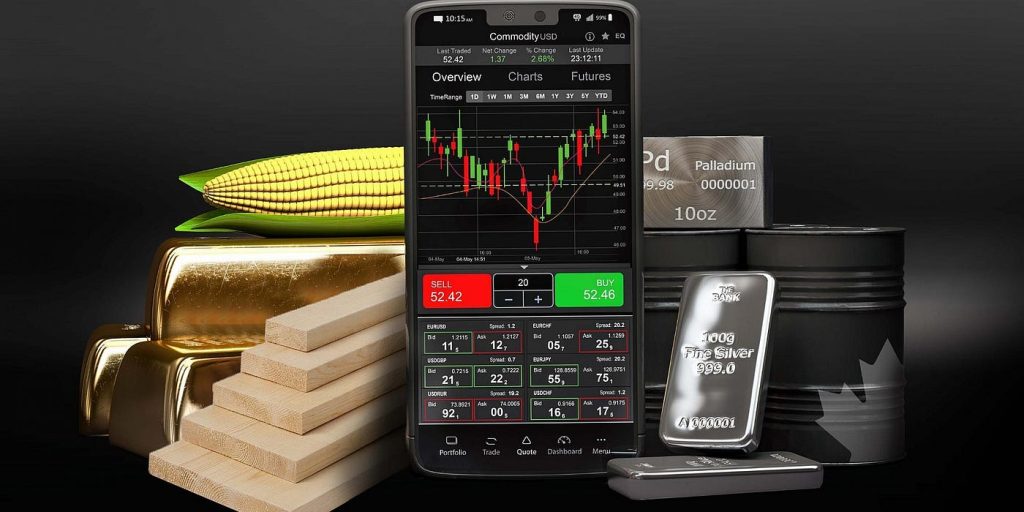Alternative investments, such as U.S. commodities, offer opportunities to diversify beyond traditional stocks and bonds. These investments include agricultural products, energy resources, and precious metals, each with distinct market drivers.
Anúncios
The U.S. commodities market is one of the largest, providing exposure to the country’s natural resources and sectors that impact both domestic and global economies. Commodities are standardized goods traded on exchanges, making them a unique investment option. Understanding these investments can enhance portfolios and help navigate market complexities.
Understanding U.S. commodity market dynamics

The U.S. commodity market is vast and diverse, divided into four main groups: energy, metals, agriculture, and livestock. Energy commodities, such as oil and natural gas, are influenced by global demand and geopolitical factors. Metals like gold and silver often rise during times of economic uncertainty.
Agricultural commodities, including grains, coffee, and sugar, are affected by weather, trade policies, and consumption trends. Livestock commodities like cattle and hogs are shaped by dietary shifts and disease outbreaks. Each category has its own risks and drivers, requiring a solid understanding of the market dynamics.
Additionally, domestic and international regulations, such as policy changes, tariffs, and environmental rules, can impact supply and demand, influencing market trends. Staying informed about these external factors is crucial for making informed investment decisions in this complex market.
Diversification benefits of commodities
One key advantage of investing in commodities is the diversification they provide. Since commodities often move independently of stocks and bonds, they can serve as a hedge against economic downturns or market shocks. This lack of correlation is especially beneficial during inflationary periods, as commodities typically perform well and help preserve purchasing power.
Commodities are tangible assets, offering protection against currency devaluation and geopolitical risks. They can stabilize returns in a portfolio when traditional assets struggle. However, their detachment from broader financial markets means they can experience volatile price swings due to supply and demand shifts.
Investors should assess their risk tolerance and investment goals before investing in commodities, ensuring they understand market fundamentals and align investments with their financial objectives.
Challenges faced by commodity investors
Investing in commodities offers benefits but also presents challenges. The markets are volatile and unpredictable, influenced by unforeseen events like natural disasters, political instability, and regulatory changes. Staying informed is crucial to managing these risks.
Commodities also face global competition and market saturation, which can affect pricing. For example, an oversupply of a commodity can push prices down, impacting profitability. Investors must closely monitor market trends and supply chains.
Additionally, unlike stocks or bonds, commodities do not generate income through dividends or interest, relying on capital appreciation. This means investors should be prepared for periods of negative returns and stay actively engaged to capitalize on favorable market conditions.
Navigating the U.S. commodities market
Successfully navigating the U.S. commodities market requires a strategic approach. Investors can access this market through various means, such as futures contracts, commodity-focused ETFs, and mutual funds. Each option has its own advantages and risks, catering to different levels of risk tolerance and expertise.
Futures contracts offer direct exposure to commodity prices, allowing investors to speculate on price movements. However, they carry significant risks due to leverage and require a strong understanding of the market. Commodity ETFs and mutual funds provide indirect exposure, offering diversification and potentially lower risks.
The choice between these options depends on individual goals, risk tolerance, and desired level of involvement. Investors should weigh the pros and cons of each and consider consulting with financial advisors to develop strategies that align with their broader financial objectives.
Identifying emerging trends and opportunities
Identifying emerging trends in the commodities market can provide valuable opportunities for investors. Technological advancements, environmental sustainability, and shifting consumer behaviors are reshaping the market and creating new avenues for investment.
For example, the transition to renewable energy is boosting demand for metals like copper and lithium, which are crucial for electric vehicles and energy storage. Climate change concerns are also driving interest in sustainable farming practices and carbon credits.
By staying informed about these trends, investors can spot growth areas and adjust their portfolios to capitalize on these shifts, positioning themselves for long-term success in the evolving commodities market.
Risk management and strategic planning
Effective risk management and strategic planning are fundamental components of successful commodity investing. Dynamic market conditions necessitate a proactive approach, with investors needing to adapt to changing environments swiftly. Diversifying across different commodities and utilizing hedging techniques can mitigate risks associated with unforeseen market events.
Furthermore, setting clear objectives and aligning with comprehensive investment plans helps manage expectations and focus on long-term growth. Regular portfolio reviews and adjustments are crucial as market conditions evolve, ensuring optimal allocation of resources and continued alignment with investment goals.
Ultimately, the U.S. commodities market offers an intricate web of opportunities and challenges that require careful navigation. By harnessing information, strategic planning, and a clear understanding of market dynamics, investors can unlock the full potential of alternative investments within this vibrant sector.






